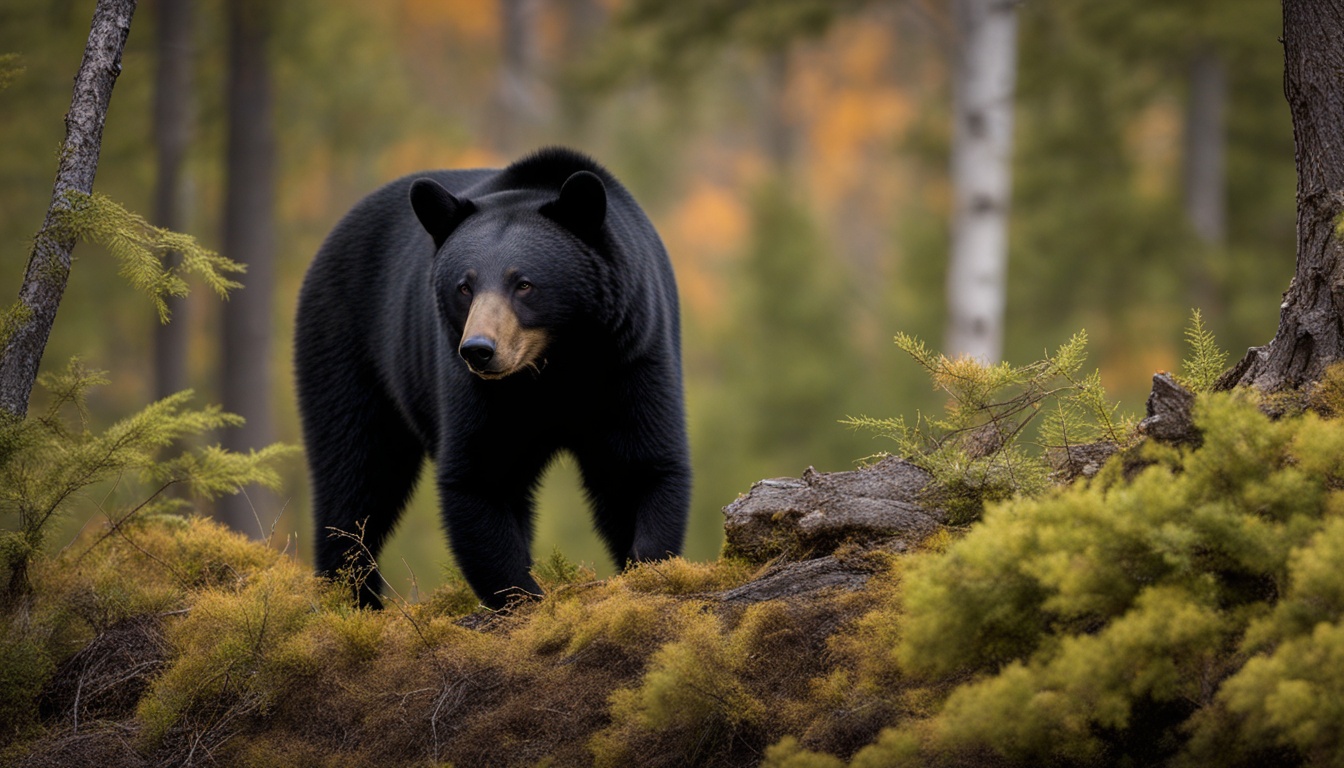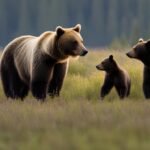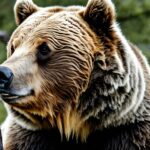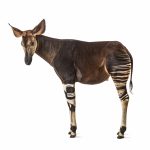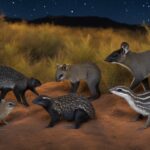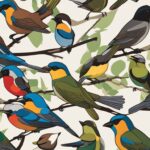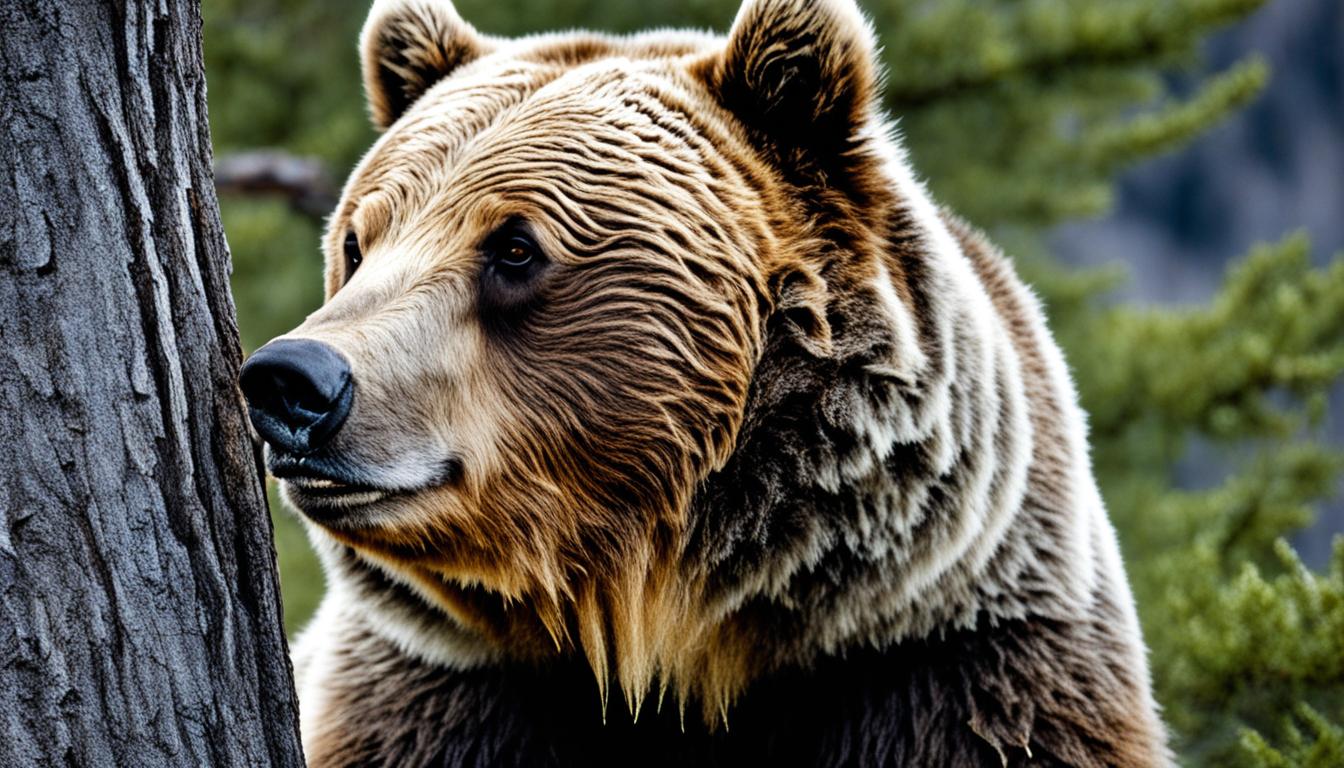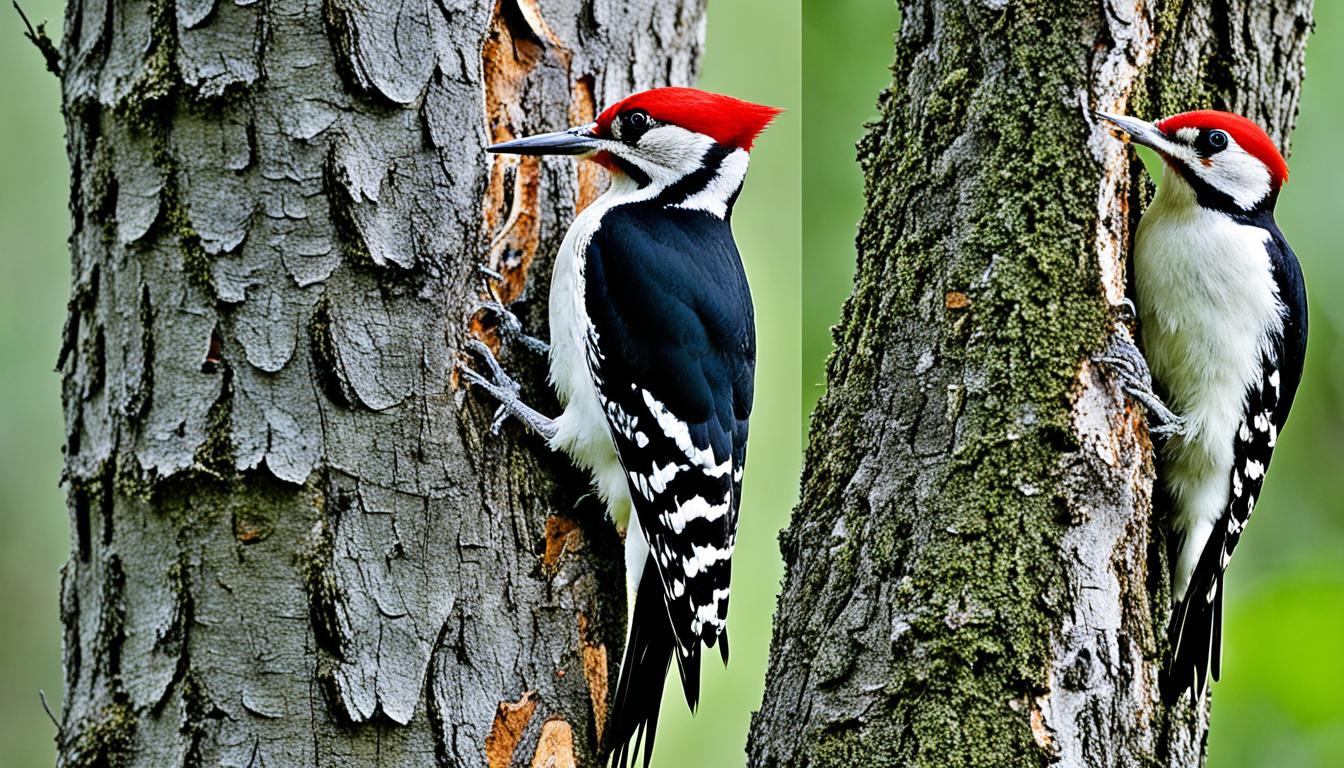Ever wondered why black bears prefer specific places even though they can live in many areas? They often choose forested places. These areas have lots of cover and trees they can climb. This is important for hiding and finding food.
Black bears are omnivores, so they eat plants, bugs, small animals, and sometimes fish. They can live in many places, like forests, mountains, and deserts. Their diet and where they live are closely connected. This shows us how they fit into their environment and help keep it balanced.
Understanding where and why black bears live in certain places is important. It shows how they can adapt and survive. Knowing this, we see why it’s vital to protect their habitats. This helps them stay healthy and diverse in the United States.
Introduction to Black Bear Habitats
Black bears, known scientifically as Ursus americanus, have fur that ranges from grey to cinnamon. They can grow up to 61 to 72 inches long. A typical black bear might weigh anywhere from 200 to 600 pounds. They rely heavily on their sharp sense of smell to find food. You’ll find black bears roaming across North American forests, mountains, and some southern U.S. areas. They show us just how flexible they are in choosing their homes.
Black bears pick their homes based on what nature gives them. A bear’s living space can be at least 24 square kilometers. This area changes a lot depending on how much food there is. Black bears change what they eat based on the season, so they need a variety of habitats to find food all year round.
Especially important for black bears is a home that’s full of plants and places to hide. This is why forests and mountains are perfect for them. They don’t just eat one thing – they like plants, bugs, and even small animals. It’s a reminder of how nature needs different places to support different kinds of life.
Black bears need a mix of trees, bushes, and open fields to find what they need to survive. By being so adaptable, black bears play a key part in keeping their homes balanced. This flexibility is a key reason why they do so well in a wide range of places across the North American continent.
| Characteristic | Description |
|---|---|
| Fur Colors | Range from grey to cinnamon |
| Average Length | 5-6 feet |
| Weight | 200-600 pounds |
| Location | Forests, Mountains, Southern U.S. |
| Home Range | 24 square kilometers (15 square miles) or more |
Forested Areas: The Primary Habitat
Forested areas are the perfect living space for black bears. They are full of delicious foods and hiding places. These environments have fruit- and nut-bearing trees, dense brushes, and succulent plants in wetlands. All these help black bears survive and thrive. Even the streams and pools provide water and cool off bears. Plus, big trees are great for playing, hiding, and resting.
Why Black Bears Prefer Forests
Forests give black bears everything they need. There’s plenty of food and places to hide from danger. They can eat from the trees and bushes, and drink from the nearby streams. This protection and food make forests truly special for these bears.
Types of Trees and Vegetation
In the forest, black bears find many food sources. These include oak, maple, and hickory trees. Shrubbery with berries, like blueberries and blackberries, are meals they love. Near water, there are also wetlands with yummy plants to eat. For safety and resting, big trees are perfect for climbing and denning.
Regions in the USA Featuring Extensive Forests
The U.S. has many forested areas that are great for black bears. Places like the Pacific Northwest and Alaska are big bear homes. The Rocky Mountains, the upper Midwest, and even the Great Smoky Mountains in the South have thriving bear populations. Appalachian forests are also ideal for these bears to live in.
| Region | Features | Vegetation |
|---|---|---|
| Pacific Northwest | Dense coniferous forests | Conifers, berry bushes, ferns |
| Alaska | Vast, remote woodlands | Birch, aspen, alder |
| Rocky Mountains | Mixed forests | Pine, spruce, fir |
| Upper Midwest | Extensive mixed forests | Maple, oak, basswood |
| Appalachians | Diverse forest ecosystems | Beech, hemlock, rhododendron |
| Southern States (Great Smoky Mountains) | Rich forest environments | Hickory, walnut, magnolia |
Mountains: High Altitude Habitats for Black Bears
The mountains have tough landscapes, perfect for black bears. These areas are rich with resources. This makes them just right for black bears to live and adapt.
Mountainous Regions Ideal for Black Bears
From the Rockies to the Appalachians, mountains are great homes for bears. They find lots of food and places to hide there. Black bears use the mountains to eat well all year round by finding berries in the summer and fall.
Behavioral Adaptations to Mountain Habitats
Black bears have special ways to live in the mountains. They know the best paths to travel on. In the spring, they eat near wetlands to get energy. Then, they fill up on berries in the summer and fall to stay healthy.
Coastal Regions and Swampy Areas
Black bears are very adaptable, living in more than just forests and mountains. They thrive in coastal areas and swamps. These places offer a lot of food and shelter which are perfect for their needs.
Coastlines and Access to Food
Coastlines are a buffet for black bears. They find berries, fruit, and lush plants, as well as a lot of insects. They can also drink and fish easily from the nearby water.
To get food, black bears are quite smart. They search the beaches and the lands near the water. This shows how good they are at finding food wherever they go.
Wetlands and Swamp Preferences
Wetlands and swamps are key living spaces for black bears. These places are full of grasses and green food that bears love. The thick plant cover also protects them and their young.
Swarms of insects and small creatures live here too. So, black bears have plenty of food to pick from in these areas.
| Habitat Type | Features | Benefits for Black Bears |
|---|---|---|
| Coastal Regions | Abundant vegetation, berries, fruit, nearby water sources | Varied diet, easy access to food and water |
| Swamp Areas | Lush greenery, sedges, moisture-rich vegetation | Nutritional plants, rich foraging opportunities, shelter |
Seasonal Habitat Shifts
Black bears show amazing adaptability through seasonal habitat shifts. These changes are key to understanding how bears make the most of their surroundings all year round.
Spring and Summer Habitat Preferences
In spring, bears like spots close to early green-up areas. These places let them eat fresh plants to gain back their winter weight. When it gets warmer, bears choose spots with lots of new plants and tender shoots.
Summer sees bears finding areas with many berry bushes. These spots are a buffet of high-calorie food, helping them store fat for later. Berries greatly affect where they move during these months.
Fall and Winter Dens and Habitats
Come fall, bears look for areas full of nuts and acorns. Feasting on these foods lets them bulk up for winter. They search for the perfect places to den as the cold season approaches.
Winter dens are hidden and snug, under fallen trees or in hollow logs. These spots keep them warm and safe, allowing them to stay active even in cold times.
The way bears adjust to seasonal habitat shifts shows their incredible ability to survive. It also underlines how crucial diverse, changing environments are for their annual cycle.
Impact of Human Activity on Black Bear Habitats
The way people live affects black bear homes in big ways. The growth of cities and towns means there’s less land for the bears. This makes their living areas smaller and divides them, making it hard for bears to move and find food.
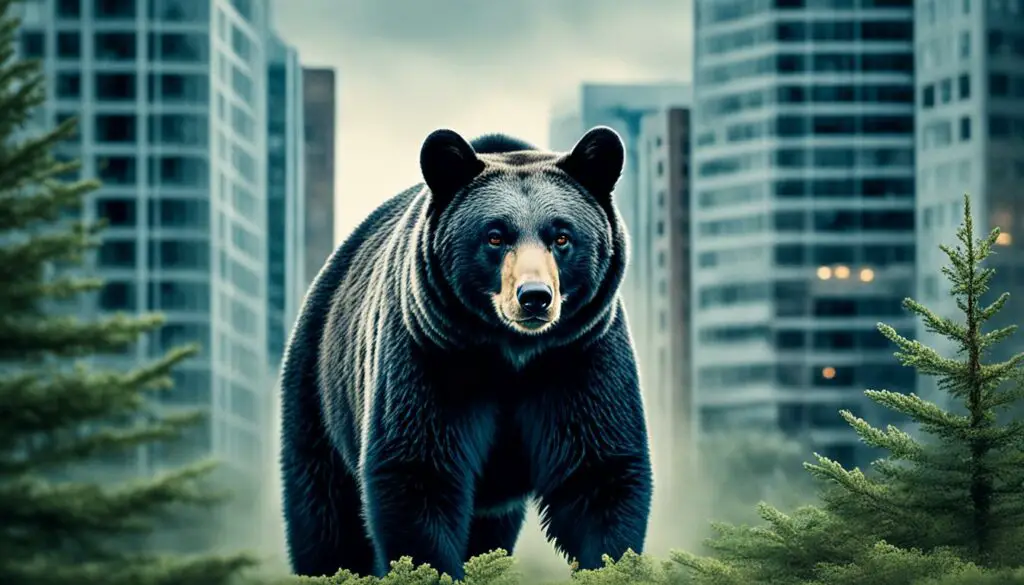
Urban Encroachment and Habitat Loss
The spread of urban areas is a big problem for black bears. Cities and towns often grow into the bears’ lands. This takes space away from them and makes it harder for bears to find the things they need to live.
Conservation Efforts and Protected Areas
To help black bears, there are special efforts to save their homes. Making protected areas and pathways for wildlife is crucial. These places give black bears larger, connected spaces to live, making their habitats safer.
Conservationists are hard at work to keep black bear populations healthy. They focus on saving the land where bears live. This work is key to making sure black bears have a future in our natural world.
Home Range and Territorial Behavior
Black bears show special ways of acting in their areas. This behavior tells us a lot about how they live and get along. It’s all based on where they can find food and resources.
Size of Home Ranges
The black bear home range varies a lot, mostly because of where food is. Males often have bigger areas that cover many females’ territories. Females, though, have smaller areas, especially when they have cubs. This is to keep their babies safe and to avoid danger.
| Black Bear Type | Estimated Home Range Size |
|---|---|
| Adult Male | 50-150 square miles |
| Adult Female | 10-40 square miles |
| Females with Cubs | 6-19 square miles |
Territorial Overlaps and Behavioral Insights
Territorial behavior black bear studies show something cool. We see that bear areas can overlap, especially where there’s a lot of food. Males sometimes share their space with several females. This can lead to more chances to mate. It’s a smart move that helps bears use resources better and keep the population strong.
Understanding how black bears use their space and share it helps us know more about how they live. With their different area sizes and how they sometimes overlap, bears show they know how to make the best of their habitats. This shows their clever ways of getting by where they live.
Diet and Its Influence on Habitat Selection
The food a black bear eats greatly affects where it chooses to live. They eat a lot of different things like berries, fruits, and insects. Sometimes they also eat fish and small animals. Because of this varied diet, black bears pick places with lots of these foods.
Omnivorous Diets and Food Sources
Black bears have a sharp sense of smell that helps them find food. They search for berries and fruits in forests. These are key parts of their diet. They also eat insects for protein, and sometimes fish and small mammals. This need for a variety of foods guides where black bears make their homes, preferably where they can find different food sources.
Seasonal Food Availability and Habitat Shifts
Food that comes and goes with the seasons affects where black bears live. In spring and summer, they look for places with lots of plants and berries. When fall comes, they move to areas with nuts and other fall foods. Winter months find them in dens, choosing spots that keep them safe and warm. We see how black bears adapt to changing food sources all year long.
Conclusion/A Recap of Black Bear Habitats in the USA
American black bears are amazing because they can live in many places. You can find them in dense forests, mountains, and even by the coast. This shows how they can adapt well to different kinds of places. Each habitat gives them what they need to live, like food and a safe home.
However, human actions are making things harder for these bears. Building in their homes and cutting down trees threatens where they live. This is why we must work hard to protect their homes. By doing so, we help black bears have the right places to thrive.
We also learn that black bears move around based on the time of year. They go where they can find food and start families. Knowing this helps us make sure they have what they need to keep growing in numbers. Protecting their homes is key to keeping our natural world in balance.

